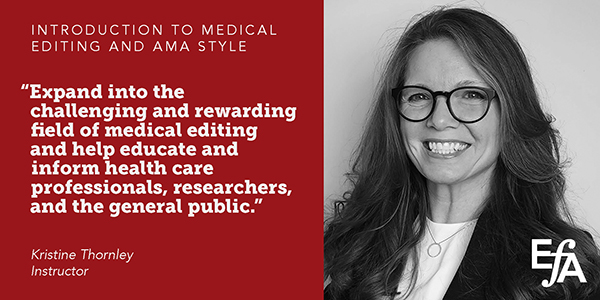Description
Self-paced courses are undertaken by the student at their own pace. No instructor feedback is given, although models are provided in the lessons. All self-paced courses include at least one live Q&A session, held via Zoom. Students will have 365 days to access the course material. To extend access by 3 to 12 months from the initial access end date, email the education coordinator. More information about how our classes are conducted is available here.
After placing your order, your course will be added to your personal course library on our education site. That site has different login information from the main EFA site. Please check your email for information on how to access the course.
Access to course materials begins immediately and lasts for 365 days.
Medical editors play a crucial role in ensuring that medical information is communicated clearly and effectively to its target audience, be it health care professionals, researchers, health care decision-makers, or the general public. Medical editing can also be a lucrative career. Take your first glimpse into this challenging and rewarding field with this introductory course.
This 12-module self-paced course, designed for editors with intermediate-level copyediting knowledge, will build on those skills and introduce you to the world of medical editing. Medical editing is a specialty that requires additional knowledge and training above and beyond conventional copyediting. This includes medical knowledge, such as medical terminology and basic medical and health concepts, as well as knowledge about basic statistics, proper presentation of data in tables and figures, and citing resources. Medical editing also has its own style guide, The AMA Manual of Style: A Guide for Authors and Editors, 11th edition, which sets the standards for writing, citing, and publishing in the medical field.
This course will introduce you to medical editing, following AMA style and best practices in the field. Upon completion of the course, you will have the knowledge, resources, and skills required to:
- demonstrate a comprehensive understanding of the AMA Manual of Style, including its purpose, organization, and key principles;
- understand and use basic medical concepts and medical terminology, including commonly used medical abbreviations, acronyms, and terms;
- review, revise, and improve the clarity, consistency, and accuracy of medical content following AMA style guidelines;
- edit scientific data presented in various formats, such as numbers, statistics, tables, figures, and graphs, following AMA style;
- cite and format references from various sources following AMA style; and
- understand the role and importance of the medical editor within the field of medical communication.
Access to The AMA Manual of Style: A Guide for Authors and Editors, 11th edition, is beneficial but not required for this course.
This course is appropriate for those who already have formal training in copyediting and/or intermediate-level experience. A science background is not essential for this introductory course.
Kristine Thornley has worked as a medical editor for over 15 years. She has extensive experience in editing medical and scientific material both in house and as a freelance medical editor. She also teaches editing courses at George Brown College in Toronto, Ontario, and Queen’s University in Kingston, Ontario. Kristine received her BSc in neuroscience and biology from the University of Toronto, certificate in publishing from Ryerson University, and MSc in health communication from Boston University.



